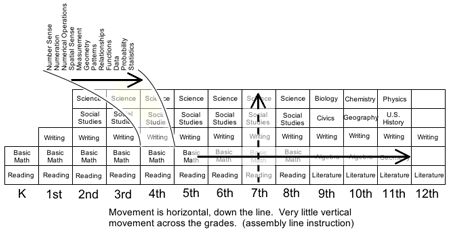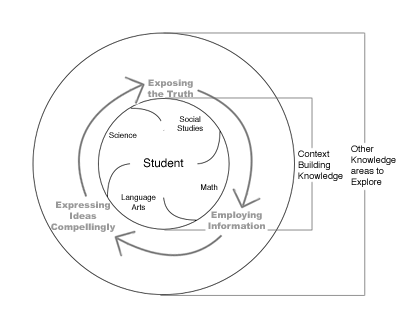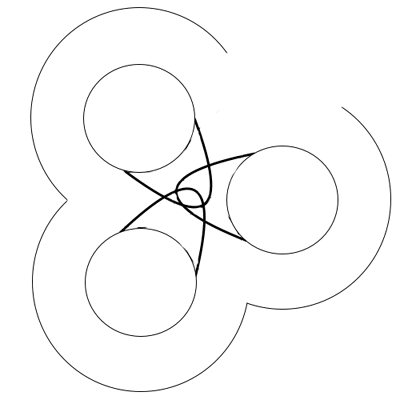A few months ago, the folks at WorldBridges hosted a discussion with me and Terry Freedman, from the U.K. The discussion got casual, and I casually used the term Shallow Standards. Its a term that I’ve used before, and especially in my “Redefining Literacy…” book. The problem is that the term requires a lot more context than I gave in that conversation, and now several bloggers have picked up the term. I’d like to spend this space with a bit of a discussion, to build some context.
First of all, some assumptions:
- Standards are the bits and bodies of knowledge and skills we expect to be taught and that we expect all students to learn.
- Shallow is “Measuring little from bottom to top or surface; lacking physical depth.”*
- Competition is an act of “measuring oneself against others”*, given similar conditions, resources, and goals.
- Cooperate is to “work or act together toward a common end or purpose”*, each contributing unique resources, skills, and perspectives to the task.
- That it is not appropriate and even counter-productive to say that we are educating our children so that we can compete in a global economy. It is more productive to say that we are preparing our children to cooperate in a global economy.
- For a future of rapid change, it is critical that we teach our students to teach themselves. Life-long learning skills should be an explicit part of what our students do in our classrooms.
* Dictionary.Com
In a pre-life-long Learning environment, the task of education was to teach all of us the knowledge and skills that we would need to know and to know how to do to become employed. After our schooling, we got a job, and kept that job for 35 years. We did some learning “on the job”, but not for the sake of a changing environment. It was for the sake of our job. It was considered part of the job.
In a world that demands life-long learning skills, it is a mistake, and even arrogant, to believe that defining a robust body of knowledge and pressuring teachers to teach that body of knowledge to all students will lead to a successful future. Instead, success in a rapidly changing (flat) world happens to people who are, according to Thomas Friedman, The World is Flat:
- Special
- Specialized
- Highly Adaptable
- Anchored
There are only a few special people. I don’t know any. Michael Jordan is special. Anchored people draw income by touching us or something that we own. These are barbers and chefs. But both of these categories of workers will live off of the economy that is generated by those who are specialized (can do things or know things that no one else does) and the highly adaptable (can learning things, unlearn, and relearn very easily).
It’s the middle two that we must focus on as educators. Our students must leave school able to make themselves experts and able to teach themselves, becoming learners and relearners. Our current model does not do this. Currently, our process is the have a blueprint (the standards), and
to usher our children through assembly lines,
installing the elements of the blueprint,
and then applying quality control at the end,
making sure that every child knows the same things,
thinks the same way, and
solves problems in the same way.
In their future,
it won’t be what they know that’s the same
that will bring success to their endeavors.
It will be what they know that’s different,
how they think that different,
how they solve problems that’s different.
|
This is why I believe that our standards should be made much more shallow. Schooling should be responsible for assure that every student knows only that knowledge and those skills that create a productive context for the lives of all students. As a society, we must have a common sense of where, when, what, how, and why we live; and how our environment affects us and how we affect our environment. Schooling should also assure that each student has the basic literacy skills appropriate to the contemporary information environment.
Students should spend a predominant amount of their time making themselves experts in areas of knowledge and experience that are especially interesting to them, and then sharing their gained knowledge and experience with other students. We go from a curriculum model that looks like a hall way that students move down, being saturated by a robust set of knowledge array of disciplines, with little integration of subject areas:

..to a curriculum model that that looks more like a sphere with the student in the middle. The smaller version of the sphere represents the knowledge and skills that are essential to building a context for the students, and the larger sphere represents everything else that is available to learn:

A predominant part of the students schooling involves identifying an area of interest and learning all that they can, leading to a valuable product, and a learning experience for the rest of the class (I use the term class loosely). The teacher crafts the students self-teaching experiences to assure involvement in all areas of context (geography, culture, history, science, economy, society, and contemporary literacy). The result is a presentation of some sort that provides a rich exposure to the area of interest to the rest of the class.

Collaboration occurs when more than one student (in the same class or at a distance) has the same interest and works together on their learning. Of course, collaboration takes on many other forms as well.

This is fairly out there, and totally counter to the current instructional model that is being imposed on us.
Please feel free to tear it apart and share your own model.
But what we’re doing now is wrong, dangerous, and not in our (U.S.) national interests. Of that, I am sure.
Figures come from
(Warlick, David. Redefining Literacy for the 21st Century. Columbus: Linworth, 2004.)

Brilliant. Being a very “visiual” learner, this one taught and reinforced some of my thinking down to the core of my beliefs. This one will stick in my thinking for a while.
How is this similar to or different from existing progressive models of school design?
It may not be different. It may not be the same. It’s just part of an ongoing conversation. If this model is easier to talk about, then let’s talk.
— dave —
Well, it’s only 5:30am and you already have me thinking way too hard before my first cup of coffee. One that that comes to mind is reading/writing. Literacy in this new age is probably the most important skill we can teach students. If you can’t read and write how do you participate in a read/write digital environment? I’m thinking about those 2nd graders you met the other day. Are they prepared for this or in primary grades do we focus on ‘the basics’? At what grade/age do we allow students the opportunity for this ‘free flow curriculum’? The American education system, I thought, was based on the premise that we want to educate the ‘whole child’ (K-12) and then in college allow them to find their direction, become specialized and highly adaptable. When or at what age do we make the switch from educating the whole child to creating a specialized, highly adaptable productive member of a global community?
I agree with everything you said, I’m just trying to figure out what this means on an elementary school level. Thanks for making me think!
From your fingertips, David, to the eyes and ears of administrators all over the United States. This model makes sense!
Excellent visualization of your thoughts and I couldn’t agree more. The Literacy Standards, in particular, do not prevent us from developing lessons which address cross curriculum content or from cutting across grade-level standards. I believe your model can and should co-exist with the Standards. It is your model which will ensure that the starndards not shallow. It took many years for New York State to develop its Standards and Core Curriculum K-12. The investment in time and dollars to align what happens in the classroom to these standards and core curriculum is just starting to take shape. Our template over the standards can take many forms — not just a trench in a hallway that feels like a mind-numbing trap.
David:
Great Infographics. A question:
Have you researched anything about the difference between your model’s potential application for students beyond the borders of the U.S.? My experience has shown that many students in other countries (Germany, Japan, Turkey) face far greater specialization at an even earlier age.
(Wikipedia summarizes the Japanese model with the phrase, “”the nail that sticks out gets hammered.” [1] )
This, I agree with you, creates a corresponding “assembly line education.” But what then do you think about breathless media reports that the U.S. education model is so inferior to some of these same countries? Don’t many educators (NB: I’m not an educator) agree that our system is indeed inferior?
Can you give an example of a country that you think approximates your model in practice? And would you say that most of the world is even farther behind than the US?
Thanks!
(PS: Had a great time in your session in Chapel Hill.)
Chris Blow
http://NonprofitDesign.org
http://PICTR.org
[1] http://en.wikipedia.org/wiki/Japanese_Education#History
It’s sad, but I think it will take a major shock to move education as a whole to think in ways that have content areas integrated to the point where they will start to feed on themselves. The IR/cookiecutter model will be here for a while because it’s easy for people to “bean count” it and to export to a standardized test.
The irony is that in a “flat world” it seems that there is no “standard” problem anymore, and those who can’t pull from other areas to create a solution to a non standard problem are not going to be employed as anything more than a barista. But it is just such a world that so many students are being prepared for.
I heard Dean Kamen (the inventor of the Segway, among many other things) address the students participating in the FIRST Robotics competition a few years ago, and he really hammered on cooperation. He said that too much of our corporate mindset in the U.S. is focused on destroying the competition, rather than working with other companies. He specifically designed the rules to the FIRST program so that cooperating with other teams is required. I really wish that more educators (and business people) would have the opportunity to hear this kind of thinking.
David,
The graphics you created represent what I was picturing – everything centers on the learner. I’ve been working with teachers in networked learning communities where we may take a standard and expand on it – have students develop their own questions asking what, where, when, how, and why? I like what you said about giving crayons in Kindergarten and then taking them away later. Wow! so true, so sad
However, in Kindergarten now in many schools the teachers spend countless hours teaching these little curious minds to stand in straight lines, keep their mouths shut, and how to bubble in a multiple choice answer on a test. Ouch!!! How did we let this happen?
It’s time for a revolution – I’m starting to write again so watch out :o)
In My eCoach, there are groups of teachers that wanted to go beyond blogs, wikis, and podcasts – taffy pull as David Jakes calls it. They wanted to engage in powerful conversations and started with each learner. They created their own plans on what they want to learn. Then collaborated with others to share ideas. So I’m trying to keep up and build blogs that work this way – wikis that allow for collaborative planning, and put in video and podcasts to share their stories. It’s getting very exciting but I and you know this is a long road.
When you started the New Century Schoolhouse – everyone could build their own classroom and then elearning. Then you talked about building collaborative textbooks and now wikibooks. I believe stories and conversations will be the next revolution. The way it will happen may be starting with a standard – asking a question – inviting others to walk down the virtual road and explore. Maybe asking questions that really mean something and coming up with solutions that can change their future. I’ll stop for now but keep the conversations going….
Barbara
http://my-ecoach.com
I am a teacher coach at an elementary sight and have begun to make powerful changes at my school in the area of student centered learning. We are teaching kids using the Inquiry Process where they come up with a question, make a conjecture (yes, we use this word in K too), decide what resources they need, and investigate to find the answer. In the end, they present to others what they learned. I have emphasized process over product, and this takes some of the pressure off teachers. Students rave about Inquiry and teachers seem to like it too, but they when I go off on vacation, they never seem to find the time for it. Why is it that even though they see the benefits, they don\\\\\\\\\\\\\\\’t make it a priority??? I believe the Inquiry Process is teaching my students to \\\\\\\\
This makes no since get a life man